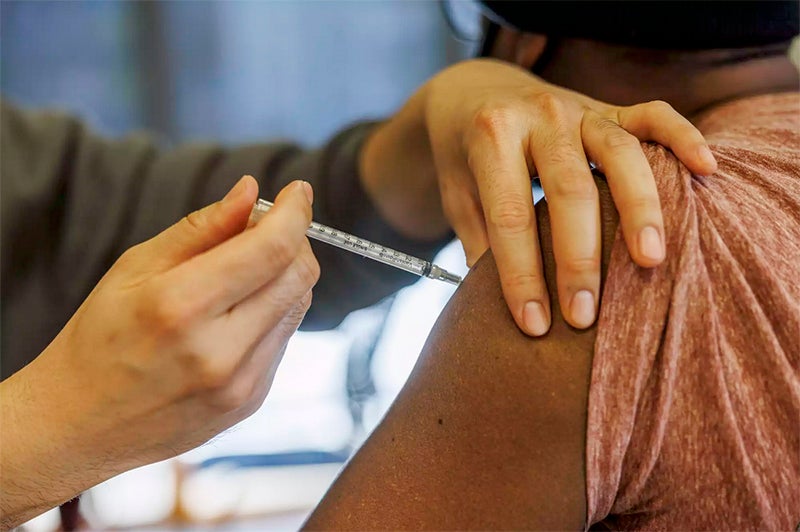COVID-19 ticks down in Minnesota, Flu and RSV barely present
Published 3:08 pm Friday, October 13, 2023

- A M Health Fairview nurse gives a Pfizer-BioNTech booster shot at a pop-up COVID-19 vaccination at Brian Coyle Center in M Health Fairview in Minneapolis on Jan. 6. Kerem Yücel/MPR News
|
Getting your Trinity Audio player ready...
|
By Elisabeth Gawthrop and Craig Helmstetter, Minnesota Public Radio News
Emergency room visits for COVID-19 have dropped during the last couple of weeks in Minnesota.
While there is no guarantee that trend will continue, there has been a longer downward trend for the United States as a whole. That may be a sign that COVID ER visits will continue to decline in Minnesota as well.
‘Tis the season, however, for two other major respiratory illnesses to become more prevalent — influenza and respiratory syncytial virus, or RSV. So far, flu is barely registering above zero for Minnesota ER visits. Flu visits in the United States overall have increased in recent weeks but still remain very low — below 0.5 percent. RSV visits have also increased nationally but remain at zero in Minnesota. In case you missed it, our last update includes information about preventive options for all three viruses.
More on the latest COVID-19 data in Minnesota below, but first an update on the lingering aftereffects of COVID on the cardiovascular system.
New evidence linking COVID-19 to cardiac issues
Scientists have now identified how SARS-COV2 — the virus that causes COVID-19 — leads to heart problems during and after COVID infection.
Researchers at NYU studied the arteries of eight people with a history of hardening of the arteries who died of COVID-19. They found the virus present in the arterial heart tissue, as well as in local immune cells called macrophages. These cells are designed to protect the heart by getting rid of excess fat molecules, but in response to COVID infection they release inflammation-producing cytokine proteins.
The team also studied tissue from other patients, and together the evidence they collected found that “macrophages rich in engulfed fat were invaded more frequently” by the coronavirus infection, and for a longer period of time, than those with less fat, according to a press release from NYU. This misplaced inflammatory response is thus more likely to occur in people who already have plaque in their arteries, but if the inflammation is severe enough, it could make it easier for plaque to grow and for clots to form even without pre-existing conditions.
The researchers think these findings may relate to long COVID as well, since the immune cells may be serving as a reservoir for the virus, allowing it to linger in the body.
A study from earlier this year found that in a 12-month follow-up period, 2.8 percent of people with long COVID died, compared to 1.2 percent of people who had never had COVID. Pulmonary embolism and cardiac arrhythmia were the conditions with the most elevated risk among the long COVID group.
The time during which the cohort of people were studied, however, predated the availability of COVID vaccines. Another study from this year found that vaccination lowered the risk of severe cardiac outcomes by around 40 percent in the 180 days following infection.
If you have recently had COVID and have chest pain or shortness of breath, call a doctor. If you have a sudden onset of shortness of breath that lasts more than five minutes, especially accompanied by sudden chest pain, or if you have severe chest pain or blue lips, call 911. More on when to see a doctor from Johns Hopkins here.
COVID-19 turnaround?
One new data point does not a trend make — but it could be a sign of hope. After eight consecutive weeks of increases in COVID-19, hospital admissions finally saw a downtick in the week ending Oct. 3. During that week, 212 Minnesotans with COVID-19 were admitted to hospitals throughout the state, down 15 percent from the 248 admitted in the previous week.
This is up from weekly COVID-19 hospital admissions of 50 or fewer in June. However, it is important to note that hospital admissions remain relatively low: those 212 admissions are only roughly half of the 400 or more COVID-19 admissions per week observed in Minnesota at the start of the year, and well below the peaks of 1,800 COVID-19 hospital admissions per week in late Nov. 2020 and over 1,500 per week in Jan. 2022.
The latest statewide wastewater data also shows a hopeful downtick. COVID-19 levels have decreased by 21.5 percent when comparing the most recent reading, Oct. 4, to one week earlier. This statewide decrease reflects decreases in six of the seven regions in the University of Minnesota’s Wastewater Surveillance Study; only the North West region saw a weekly increase.
COVID-19 death rates, which are currently finalized through the middle of last month, do not yet reflect this recent downturn in COVID-19 activity. The Minnesota Department of Health’s latest data show that an average of about two Minnesotans per day lost their lives at least in part due to COVID-19 in mid-September, which, like hospitalizations, was up from summertime lows of less than one COVID-19-related death per day, but much lower than earlier periods of the pandemic.
The downticks in COVID-19 measured in wastewater and reflected in hospital admissions coincides with the introduction of new COVID-19 booster vaccines on Sept. 14. It is very unlikely, however, that uptake in the new vaccines is already contributing to decreased COVID-19 activity.
As of Sept. 23, the latest vaccination data available through the Minnesota Department of Health shows only 11,314 Minnesotans, 0.2 percent of the state’s population, had received the updated booster.




